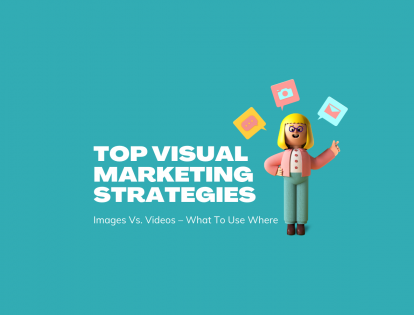Strategic Marketing Tactics Depend On The Situation
Marketing is straightforward and downright abstract. How is this the situation, and why? Well, there are a few things you want to think about. For one thing, the “goal posts” of technology are constantly changing. Just look at history. A hundred and fifty years ago, pamphlets and posters with the latest colors were top-of-the-line.
Soon the telegraph and phonograph came around and new entertainment mediums gave way to new methods of spreading information. This developed into radio and moving pictures. Fluttering around these things from the mid-1800s until the advent of “talkies” were traditional photographs. Soon, colored film became popular, and then there was television.
These seismic shifts eventually gave way to home video, then the internet, then cloud computing, and as cloud computing spread like a cumulonimbus thunderhead on the horizon, handheld mobile technology with web access began to define everyone’s life on a daily basis. Mobile web tech and the cloud gave way to IoT, or the Internet of Things.
Today, more people access the web via mobile devices than desktop devices. So throughout each of these iterative shifts, marketing best practices transitioned. They had to—and sometimes, marketing segues even led “the charge”. Now, social media is a prime marketing avenue, and the visual element is more important than ever. With that said, many businesses aim to produce compelling and engaging graphics. For example, they could hire design services or tap agencies in Pittsburgh to do their graphic design work.
People Resonate With Visual Media
You know the old saying: a picture is worth a thousand words. By that logic, a piece of film must be worth a million or more, depending on its length. At thirty-two frames a second, that’s 32,000 words per second. A single minute of footage becomes 1,920,000 words—by that logic.
Obviously the metaphor breaks down a little. But there’s a new visual option on the horizon: the meme. What is a meme? Well, it can be a single picture, it can be a short animated .gif, or it could even be a small amount of film with a little sound, even.
Essentially, a meme is a means of co-opting visual media for a collateral purpose, usually humorous, often political. Sometimes this is done with original media, often well-known images are captured. People also like something custom-made such as cat paintings or a portrait of their kids so make sure to show them such visuals too.
A Closer Look At Memes
For example, there’s an image of Leonardo DiCaprio in his “Calvin Candie” costume from Tarantino’s Django Unchained. The meme is a still shot of DiCaprio laughing in a way that appears a bit self-centered—like he made a joke, and it’s hilarious to him, even if you don’t find it remotely funny. That image is photoshopped, altered, and tagged everywhere.
A meme advertisement might take that image and put text at the top saying something like “You must get all kinds of traffic…” and then the bottom would read something like “…from that leaflet campaign.” The sarcastic expression on Leo’s face contrasts the text to make it a sort of sardonic joke.
Then, either under the image or atop it, would be the marketing company’s name—most likely a company dealing in the latest marketing trends.
So in that sense, not only does the picture tell a thousand words, but the meme itself tells a few thousand more by implication, and they can be geared at simple entertainment or marketing. The thing about using memes as an avenue for marketing is, they have to be legitimately qualitative. If you’re “kitschy” or “hack” or “basic”, they’ll be reviled like an odor.

(An animated rendering of Bernie Sanders is a popular meme.)
Infographic Angles
There’s a level of organic authenticity that becomes necessary if you’re going to use memes in a marketing capacity. Given the risk, unless marketing groups acquire exceptionally savvy, trendy marketers to design such media, many operations tend to lean away from this form of visual engagement. Infographics tend to be a little bit more effective here.
An infographic uses text, drawings, and a larger-than-usual size to condense key information in a way that’s easy to process by the broadest “common denominator” of a given businesses’ core demographic. Certainly, you can make your own infographics with Microsoft Paint, or any old photo-editing program. It’s better to use an online tool such as Venngage’s infographic maker or others you can find on the internet, though.
Marketers understand what sort of image types are best, associated quality in dimensions, and how formatting can assure mobile and web portals are able to properly process such images. Infographics can be multiple file types, and multiple sizes. Some are going to be easier for you to view on a smartphone than others.
So memes and infographics are popular twists on traditional image-based marketing; but they can’t replace the video element. In terms of communication ability, videos are hard to surpass. Educational videos can reach a wide variety of target clientele—but video engagement levels differ. Most people tend to only watch a few seconds or a few minutes of a video.

What Works And What Doesn’t In Video
By now, you’ve likely encountered ads for those multi-level marketing groups where a young trendy guy pulls up in a Tesla, pops out the sunroof, and says: “I went from nothing to millions in months, and I’m going to tell you all about it, and how to do it, and why to do it, and where to do it, and what time of day it is,” and then just keeps droning on never getting to the point.
The reason they do this has to do with maintaining engagement. Many potential customers will turn away if the “title” of the video is immediately “fulfilled’. If the title of your video is “how to make money instantaneously”, and the first thing out of the guy hosting the video is something like “rob a bank”, viewers won’t keep watching. They got the answer to the lead-in.
So part of the way in which you present a video will have to do with its very title. You want one that piques viewer curiosity so they follow through till the end. That can be hard. For this reason, a lot of clickbait makes promises the content it labels never really delivers on. That’s a bad marketing tactic—it’s cheap, and likely won’t be sustainable over the long term.
Best Practices In Video Lists And Similar Content
However, if you’ve got a bunch of useful data, that could maintain engagement. So you might title it: “10 ways your business can save money”, and then have a text subtitle pop up during the introduction that says something like “stick around until number one for a surprise”. After that, you count down from ten to one based on the quality of a given tip.
In the middle of the video, or right before the final entry, you want to do a “pitch” to “like, share, or subscribe” to the channel producing such videos. However, people aren’t as likely to sign up to a channel that only produces commercials, as they are to a channel that has entertaining and engaging content.
So in that sense, the channel may have as its ulterior purpose marketing, but directly, the purpose should be some form of engagement at least tangentially related to basic entertainment. Humor sells and sensuality sells; but humor tends to be more universal. So being casual and funny has its place, unless clients are only of the exceptionally serious type.
Social Media Options In Terms Of The Pictorial Visual Element
That’s the visual element in terms of video expression. When you lean into strict pictorial expression, a whole new set of rules apply. So we spoke about memes, infographics, and video. Now you want to think about images calibrated specifically for social media. Sometimes all you need is a creative filter on Instagram or Tik-Tok.
At the following site you can find some of the best Tik-Tok filters for selfies. If you’re a clothing company, or you’re selling things like sunglasses, jewelry, headphones, or swimsuits, then what you want is an attractive model filtered through some interesting software option in social media apps like Tik-Tok and Instagram.
It’s worthwhile to maintain accounts on multiple social media platforms. Sometimes one will do better for you than it does for your competition. Sometimes your particular business lends itself more to one sort of social media over another. For example, if you’re an employment agency, you might want to forego Tik-Tok and Instagram altogether, leaning on LinkedIn.

Where Twitter And Facebook Fit In
Twitter is a great platform to be visible on if you want to have a lot of back-and-forth with customers. Given the size of tweets, you can easily communicate in a way that saves a lot of time. Facebook is better for glorified PPC (Pay Per Click) campaigns and long-term discussions. You can get in a months-long viral argument if you’re not careful.
However, there are situations where courting controversy ultimately provides better opportunities for your business. Also, you can combine text and video by going “live” with members of your marketing, sales, or productive team. You want to be careful going live, though; you can’t unsay some things.
In order to find your balance between visual media outreach in modern marketing, you will likely want to explore a few trial and error approaches. Getting a little advice from professionals who specialize in modern marketing best practices does make a lot of sense. You can also get support from an online coach who can give you some guidance and tips to achieve all your marketing goals.
Unless you can afford to hire internal marketing teams who have a cutting-edge familiarity with the latest trends defining their professional purpose, outsourcing tends to be more affordable. You get better results more consistently for less. However, to get results, you do need to keep solid metrics on how your marketing campaigns are performing.
The Value Of Outsourced Marketing
Outsourcing helps here as well. The thing is, if you’re diligent about keeping metrics and exploring multiple outreach avenues, you may well be able to get similar results all on your own. It’s a rare thing, because most running businesses are more concerned with making profit from their primary work than enhancing sales collaterally through marketing.
However, if you’re savvy enough to use visual stimuli the right way across the right sort of social media, you may be surprised the levels of engagement you can get. To that end, remember that visual stimuli used in marketing have shifted in modernity largely owing to technological segues in this area.
Instead of infomercials, viewers will be interested in top-ten YouTube vides that provide valuable insights to target clientele about pain points or other things relevant to either the video’s subject or your business. Instagram tend to be superior to Tik-Tok in some respects, and vice-versa—depending on the sort of visual content and visual filters you use.
Stay Aware Of Trends: The Next Visual “Shift” Is Coming
Finally, be ready to upgrade what you do as technology shifts. The Internet of Things extends beyond tablets, laptops, and smartphones. There are smartwatches, smart fridges, smart cars, smart LED lighting—and the list goes on. Video games (see, for example, Steam keys) are more realistic than ever. Also, Virtual Reality, Augmented Reality, and Mixed Reality (VR, AR and MR) are here.
Accordingly, you’ve got to be ready for another iterative shift near on the horizon. 2020’s lockdown is leading into such shifts, and you can expect that the development of memes will continue until some new entertainment media animal has become prominent. This is yet another reason to outsource, but if you’re savvy, you can stay on top of things on your own.
The good news is, though technology and trends continue to develop year over year, the way in which they develop tends to build on previous trends. You needed film before you could have television, and television before you could have online video. Before there could be memes, there had to be subject matter to co-opt for secondary purposes that way.
In the future, the visual element may have a transitory quality that reflects some individual aspect of the viewer. It’s hard to know. But if you keep metrics, pay attention, and follow what works for your business, you’ll likely see the sort of traffic engagement and product conversion outcomes necessary to determine which future moves are best.
Author Bio
Wendy Dessler is a super-connector who helps businesses find their audience online through outreach, partnerships, and networking. She frequently writes about the latest advancements in digital marketing and focuses her efforts on developing customized blogger outreach plans depending on the industry and competition.
